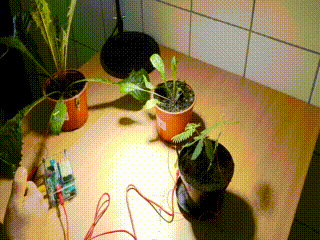Plants are capable of sending warnings to other plants, including those of other species, using electrical signals sent on the surface of their leaves, according to new research by a predominantly Polish team of scientists and funded by the Polish National Science Centre.
The study by scientists from the University of Warsaw and their colleagues at the University of Missouri demonstrates a process they call network-acquired acclimation (NAA), whereby such signals function as a communication link between transmitter and receiver plants organised as a community or network.
In one experiment, the leaves of two dandelions were put into contact, and one was connected with a copper wire circuit to the leaves of a Mimosa pudica, known as a sensitive plant because its leaves rapidly droop when touched to defend themselves from harm.
As the video recording shows, the mimosa plant’s leaves soon react when the dandelion is touched with the copper wire.

Source: The Plant Cell, M. Szechyńska-Hebda et al., doi/10.1093/plcell/koac150/6589903
“Let us imagine a meadow full of dandelions. This is not just many beautiful yellow flowers, but also a tangle of leaves of various species of plants in contact,” said Stanisław Karpiński, the head of the project, whose findings have been published in academic journal The Plant Cell.
“When an individual dandelion leaf is injured, the information is quickly spread in the form of an electrical signal through the whole plant and passed on to the leaves of other plants,” he told the Polish Press Agency (PAP).
“One dandelion uses a coded electrical signal to ‘tell’ its neighbour, ‘I’ve been wounded, look out!’ The entire meadow buzzes with information sent between plants,” added Karpiński.
Aboveground Plant-to-Plant Electrical Signaling Mediates Network Acquired Acclimation (Magdalena Szechyńska-Hebda, Maria Lewandowska, Damian Witoń, Yosef Fichman, Ron Mittler, Stanisław M Karpiński) #PlantSci https://t.co/SG59RAMrqf pic.twitter.com/rP3YST6t5H
— The Plant Cell (@ThePlantCell) May 20, 2022
“Such an electrical signal is transmitted quite fast in the context of plant reactions; it travels between several millimetres and a several centimetres per second,” explained Karpiński. “The condition is a humid environment for closing the electrical circuit.”
Plants were already known to send chemical signals as well as communicate messages through their roots to neighbouring plants about the availability of water and minerals. But electrical signals might take precedence because of their speed, Magdalena Szechyńska-Hebda, another member of the team, told PAP.
“The ability to detect danger early undoubtedly enables an individual plant to survive, and rapid communication between plants can help prepare an entire population for danger,” she explained.
“Plants are not the primitive organisms they seem to be,” said Karpiński. “They can receive, process and physiologically remember a huge array of stimuli. The level of communication between plant cells is as complicated as that in the nervous tissue of animals.”
It is not yet clear whether the information sent between plants consists of simple binary warnings or more complex information, as well as whether it is always “honest” or might sometimes be deliberately misleading.
NAA must be very old in evolutionary terms as it uses chloroplasts, which are responsible for photosynthesis, Karpiński explained. It can therefore be assumed that all green species of plants – such as trees, ferns, mosses and seaweed – can generate electrical signals.
“It is fascinating that plants can transmit information in the aboveground system so precisely, as this means they could use the same system for ‘communication’ with other organisms, such as the insects pollinating them,” say the authors of the study.
Main image credit: Martin Ludlam/Pixabay

Ben Koschalka is a translator, lecturer, and senior editor at Notes from Poland. Originally from Britain, he has lived in Kraków since 2005.




















